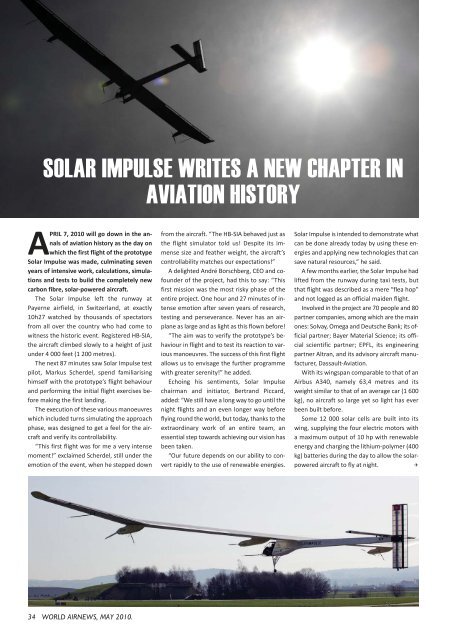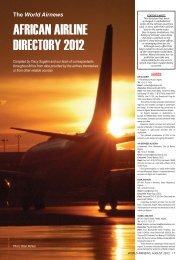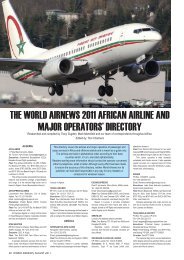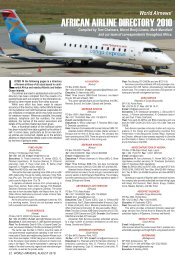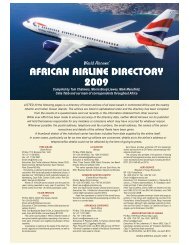May 2010 covers_Covers.qxd - World Airnews
May 2010 covers_Covers.qxd - World Airnews
May 2010 covers_Covers.qxd - World Airnews
You also want an ePaper? Increase the reach of your titles
YUMPU automatically turns print PDFs into web optimized ePapers that Google loves.
SOLAR IMPULSE WRITES A NEW CHAPTER IN<br />
AVIATION HISTORY<br />
APRIL 7, <strong>2010</strong> will go down in the annals<br />
of aviation history as the day on<br />
which the first flight of the prototype<br />
Solar Impulse was made, culminating seven<br />
years of intensive work, calculations, simulations<br />
and tests to build the completely new<br />
carbon fibre, solar-powered aircraft.<br />
The Solar Impulse left the runway at<br />
Payerne airfield, in Switzerland, at exactly<br />
10h27 watched by thousands of spectators<br />
from all over the country who had come to<br />
witness the historic event. Registered HB-SIA,<br />
the aircraft climbed slowly to a height of just<br />
under 4 000 feet (1 200 metres).<br />
The next 87 minutes saw Solar Impulse test<br />
pilot, Markus Scherdel, spend familiarising<br />
himself with the prototype’s flight behaviour<br />
and performing the initial flight exercises before<br />
making the first landing.<br />
The execution of these various manoeuvres<br />
which included turns simulating the approach<br />
phase, was designed to get a feel for the aircraft<br />
and verify its controllability.<br />
“This first flight was for me a very intense<br />
moment!” exclaimed Scherdel, still under the<br />
emotion of the event, when he stepped down<br />
34 WORLD AIRNEWS, MAY <strong>2010</strong>.<br />
from the aircraft. “The HB-SIA behaved just as<br />
the flight simulator told us! Despite its immense<br />
size and feather weight, the aircraft’s<br />
controllability matches our expectations!”<br />
A delighted André Borschberg, CEO and cofounder<br />
of the project, had this to say: “This<br />
first mission was the most risky phase of the<br />
entire project. One hour and 27 minutes of intense<br />
emotion after seven years of research,<br />
testing and perseverance. Never has an airplane<br />
as large and as light as this flown before!<br />
“The aim was to verify the prototype’s behaviour<br />
in flight and to test its reaction to various<br />
manoeuvres. The success of this first flight<br />
allows us to envisage the further programme<br />
with greater serenity!” he added.<br />
Echoing his sentiments, Solar Impulse<br />
chairman and initiator, Bertrand Piccard,<br />
added: “We still have a long way to go until the<br />
night flights and an even longer way before<br />
flying round the world, but today, thanks to the<br />
extraordinary work of an entire team, an<br />
essential step towards achieving our vision has<br />
been taken.<br />
“Our future depends on our ability to convert<br />
rapidly to the use of renewable energies.<br />
Solar Impulse is intended to demonstrate what<br />
can be done already today by using these energies<br />
and applying new technologies that can<br />
save natural resources,” he said.<br />
A few months earlier, the Solar Impulse had<br />
lifted from the runway during taxi tests, but<br />
that flight was described as a mere “flea hop”<br />
and not logged as an official maiden flight.<br />
Involved in the project are 70 people and 80<br />
partner companies, among which are the main<br />
ones: Solvay, Omega and Deutsche Bank; its official<br />
partner; Bayer Material Science; its official<br />
scientific partner; EPFL, its engineering<br />
partner Altran, and its advisory aircraft manufacturer,<br />
Dassault-Aviation.<br />
With its wingspan comparable to that of an<br />
Airbus A340, namely 63,4 metres and its<br />
weight similar to that of an average car (1 600<br />
kg), no aircraft so large yet so light has ever<br />
been built before.<br />
Some 12 000 solar cells are built into its<br />
wing, supplying the four electric motors with<br />
a maximum output of 10 hp with renewable<br />
energy and charging the lithium-polymer (400<br />
kg) batteries during the day to allow the solarpowered<br />
aircraft to fly at night. Q


